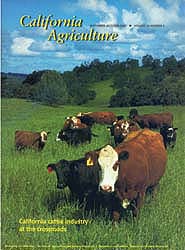All Issues

California cattle industry at the crossroads
Cover:
Beef cattle and calves are among California's top commmodities, with a farm-gate value of $1.36 billion in 2001. But with increasing packer consolidation and declining demand for red meat, the state's cattle industry faces major challenges (p. 152). An option for some ranchers may be to pursue niche markets such as grass-fed beef (p. 151). In the dairy industry, organic production has emerged as a niche market (p. 157). Ranked as California's number one commodity, dairy generated $4.6 billion in 2001 and spurred growth in the hay sector, which now constitutes the largest crop acreage in the state. Choices made by alfalfa growers and dairy producers can help protect water quality and aquatic life (pp. 148, 150, 163). Research beef cattle graze at the UC Sierra Foothills Research and Extension Center. Photo by Jack Kelly Clark.
September-October 2002
Volume 56, Number 5
Volume 56, Number 5





